Italy earthquake: 6.6-magnitude tremor rocks nation's center
A powerful 6.6-magnitude earthquake rocked central Italy on Sunday morning, injuring at least 20 people, in the strongest tremor to hit the country in more than three decades.
The earthquake follows tremors last week and comes on the heels of a devastating quake in August, which killed nearly 300 people and flattened entire villages.
Latest developments
• The quake struck 6 kilometers (3.7 miles) north of Norcia, the US Geological Survey reported.
• Fire and rescue services said six people had been pulled from rubble in Norcia.
• There were no immediate reports of deaths -- many residents had not returned since a devastating quake in August.
• There have been about 200 aftershocks since Sunday's quake in the border area between the Marche and Umbria regions, according to National Institute for Geophysics and Vulcanology.
• Some villages are cut off, so the impact there has not been assessed, said Fabrizio Curcio, the civil protection chief.
• Some 15,000 people are without electricity, according to Curcio.
• Much of the Basilica of San Benedetto in Norcia collapsed.
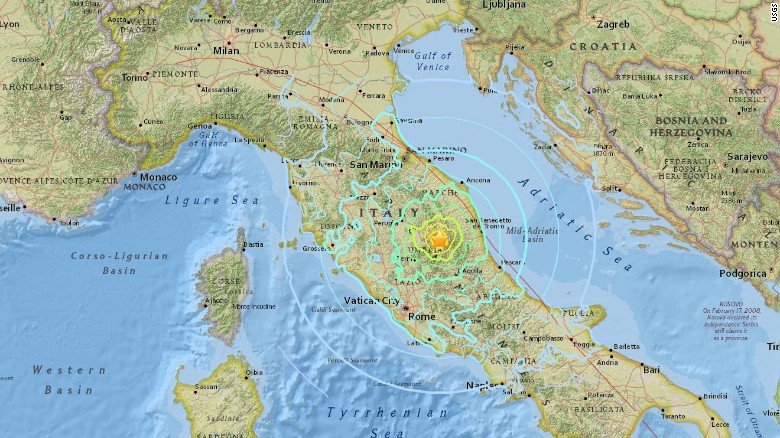
Sunday's quake struck at a shallow depth, making it more likely to cause damage.
Prime minister: 'We will rebuild everything'
Residents ran onto the streets in a panic as the quake struck at 7:40 a.m. local time (2:40 a.m. ET) Sunday, and rescuers were seen soon after, helping evacuate a group of nuns from a church. They worked through aftershocks that hit every 20 minutes or so.
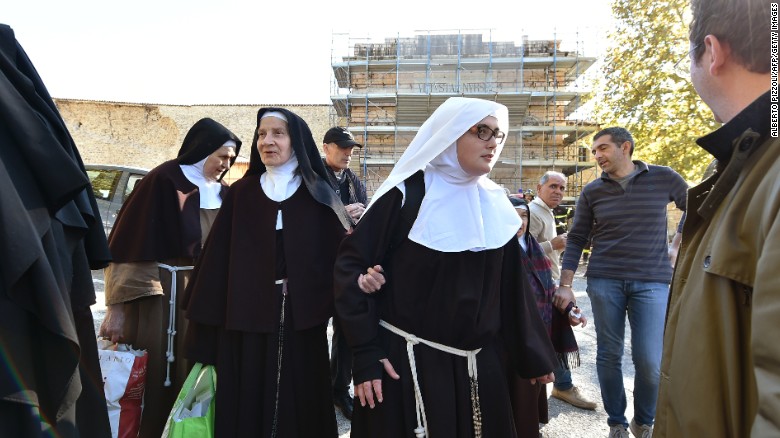
Nuns leave the center of Norcia after being helped out of a church Sunday.
Authorities are hopeful there may be no deaths since many residents in the region had already been evacuated to emergency camps and hotel rooms paid for by the government after the August quake and last week's temblors, and schools had shut down in anticipation of powerful aftershocks.
Italian Prime Minister Matteo Renzi in Rome thanked rescuers and vowed to rebuild damaged villages.
"Italy has many faults, but these situations bring out the best of us," he said, adding the country would rebuild houses, churches and shops.
"We will rebuild everything. We have the resources to do it."
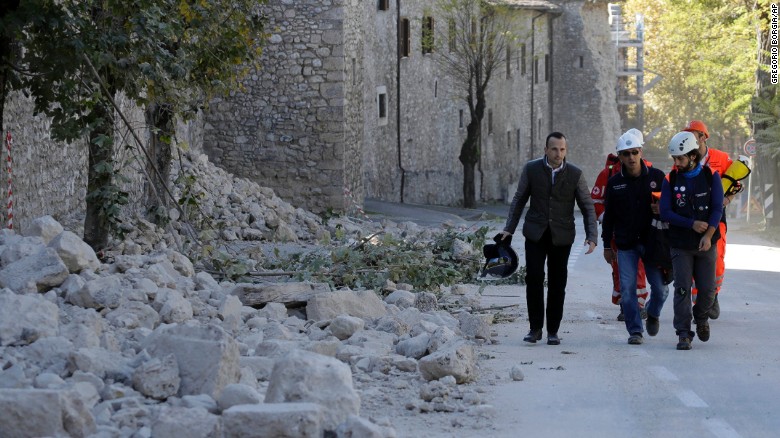
Italian civil protection staff pass a collapsed wall Sunday in Norcia after the quake jolted central Italy.
The main road into the worst-affected area has been blocked at various points, said Curcio, the civil protection chief, and helicopters were airlifting the injured to the hospital in Foligno, around 30 kilometers to the northwest. Six aircraft were monitoring the affected regions, he added.
Initial images from Sunday's quake show devastation to some historical buildings. Many of these buildings had not been reinforced since two powerful quakes struck Wednesday.
The town center of Amatrice took another battering Sunday after most of its buildings were seriously damaged in the August quake -- a lone bell tower was seen poking up among the rubble.
The much-visited Basilica of San Benedetto in Norcia was leveled at its core, only its facade still somewhat intact. Central Italy is a deeply Catholic region.

The Basilica of San Benedetto's facade remains standing in Norcia, but its core crumbled Sunday.
Residents sleeping in cars
Father Benedetto from the monastery's Monks of Norcia told the state-run ANSA news agency: "We monks are all fine but our hearts go out to those affected, and the monks of the monastery are trying to figure out if anyone is in need of their last rites."
"We rely, as always, on your prayers and your support," he said.
Many others, however, are refusing to leave, some sleeping in their cars that they believe offer better protection than the roofs over their heads.
"These people don't want to leave their area because they are really linked in. There's a long tradition there, and they have some jobs, farmers and so on, so they decide to stay there," Tommaso Della Longa of the Italian Red Cross told CNN.
"People need to understand they need to move from there, because the situation in this area is between mountains and valleys -- it's cold even now, and snow is coming in a few weeks," he said, adding it was difficult to set up support structures there.
Landslides caused the partial disruption of the course of the Nera River, and the river flooded a road to the village of Visso, already full of debris. Visso was one of the towns affected by a large earthquake Wednesday.
Technical teams inspected dams, officials said, but have not found any damage so far.
'The whole city shook'
The quake was felt as far north as the Alps, Curcio said, and as far south as Rome, some 90 kilometers (56 miles) away. The metro in Rome has been shut down as authorities continue to survey the area, municipal officials said.
Schools in Rome will be closed Monday so buildings can be surveyed for any structural damage, according to the Rome municipality website. Several buildings have suffered minor damage from the series of earthquakes.
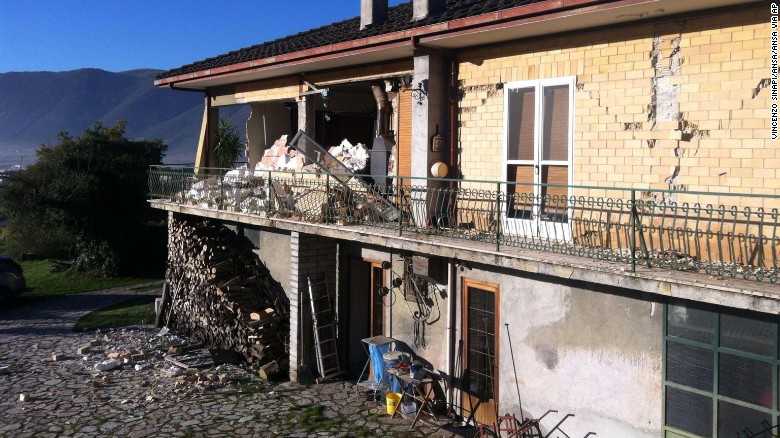
Sunday's quake has damaged a building in Norcia, where many people are afraid of leaving.
Morgan Kasmarik, an Australian journalist on vacation in the Italian capital with a friend, said "the whole city shook" when the quake struck.
"I was in bed, enjoying a Sunday lie-in, when I felt the room start to shake. Within seconds, the ground started to roll, like I was on a boat in choppy water," she said.
"We were both quite shaken as it was the first time either of us had ever experienced an earthquake. I'm pretty keen not to repeat the experience. (But) it didn't stop us, or the many other tourists from spilling into the streets to enjoy the beautiful day."
In central Italy, the people are accustomed to seismic events in their region, but not so many in such a short space of time.
CNN International meteorologist Derek Van Dam that Sunday's quake was Italy's strongest in 36 years and that Wednesday's temblors were "considered foreshocks" ahead of Sunday's "main earthquake."
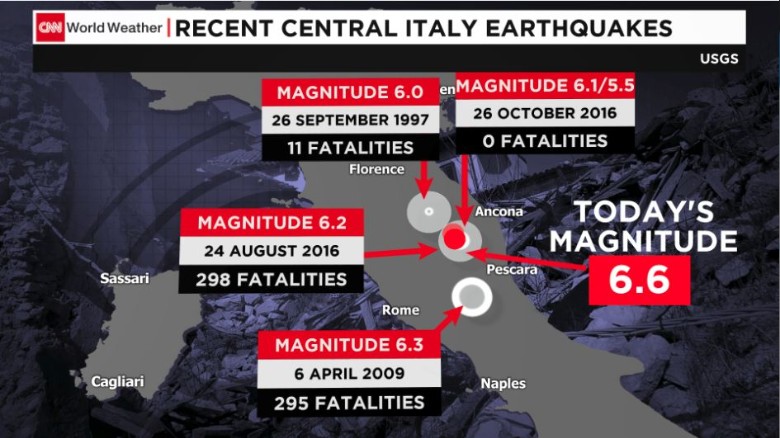
Some 13 million people would have felt weak movement in the earth, Van Dam said, while those nearer the epicenter would have experienced strong jolts.
Sunday's earthquake struck at a depth of 10 kilometers (6.2 miles), according to the US Geological Survey, making the epicenter relatively shallow. Generally, the more shallow the epicenter, the more a quake is felt at the earth's surface, and the more damage it is likely to cause.
Rescuers have expressed fear about possible mudslides and remained wary about the risk of bringing heavy equipment up narrow roads linking the towns, villages and hamlets in this hilly region of the country.
The two earthquakes on Wednesday -- which had magnitudes of 5.5 and 6.1 -- did not result in any reported deaths. But the destruction of nearby historic structures was widely seen as a loss to cultural heritage.
Powerful tremors on Wednesday and Thursday happened about 50 miles north of where a devastating quake killed nearly 300 people in August.
News Courtesy: www.cnn.com











